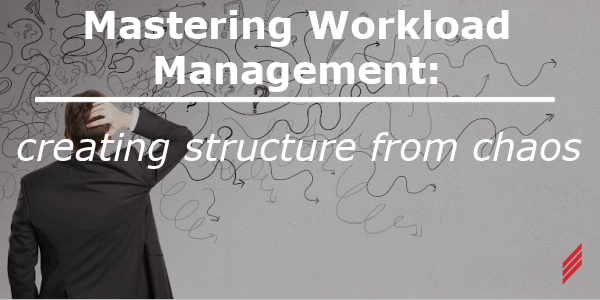Mastering Workload Management: Creating Structure from Chaos
by Charles Nicolas on May 1, 2025 10:30:00 AM

Deadlines, meetings, site visits, proposals – you name it. As engineers, we juggle these tasks on a weekly basis while also while also having to balance our personal lives and family time. We’ve all heard the phrase “Have a good balance between work and personal life,” but often that can be easier said then done. What’s the key to getting control over heavy workloads to obtain this healthy balance? Developing healthy work habits to help you stay focused and put high quality into one task at a time will allow you to leave your computer with significantly less stress and a clear mind for the next day when clocking out.
Emphasizing ‘one task at a time’ is crucial, as attempting to do many tasks at once is very harmful to not only yourself, but to your work quality as well. While it’s tempting to do so with the hopes of “getting more done”, research shows multitasking can reduce productivity and compromise work quality. So, how can we manage such high work loads without feeling overwhelmed? What if there were simple strategies to create a more structured, and more mentally cleared work environment- regardless of the level of chaos the week obtains?
Downside to High Workload
Though it is said it’s always good to remain busy, being too busy without good practice can lead to negative effects. A study conducted by Stanford University in 2014 dove into discovering such effects:
- Increase in stress and anxiety
- Poor sleep
- Decreased Productivity
- Increased Errors and defects
- Lower overall quality in work
These are just a few of many downsides to not managing a high workload. Not only will they lead to poorer performances, but also a decrease in overall health and work quality. These downsides highlight the need for better workload management. Let’s now explore strategies to create structure and clarity, regardless of the circumstances.
Creating Control from Chaos
Going into the solution, let’s break it down into parts. First prioritization, the image above represents a prioritization tool called the Eisenhower Matrix. This Matrix is divided into four quadrants to distinguish your tasks by their urgency and importance. After reflecting on the task at hand, you then make the decision to do it now, later, or delegate the work to a peer. The Eisenhower matrix is a very simple yet effective tool that, when utilized, can give you clear navigation on your current and future workload.
Second will be dissecting a large task into pieces. When taking on big tasks, it becomes second nature to be overwhelmed. Let’s say you have a CD set going out end of the week and in overview, you have 8 sheets you need to complete. Looking at the task as “I have 8 sheets I need to do for this set going out” is already creating stress to your mind as research shows the heavier the work is perceived, the more stressful it becomes. Shifting perspectives, you can look at it as “I am going to spend each day working only on two sheets, leaving me with Friday to review and make sure everything is to standard before sending out”. Such a small tweak in perspective can lead to an instrumental improvement of work, as rather than trying to take the entire job at once, you are breaking it down to a much more manageable task and even creating time to carefully review your work before the deadline.
Third and lastly, learn not to say no or delegate to tasks delivered to you when necessary. This is essential to guarantee high-quality work and keep the burden moderate. Many professionals, particularly engineers, feel under pressure to complete every work that is given to them out of concern that they would come seen as recalcitrant or inept. Saying yes all the time, though, can result in burnout, missed deadlines, and lower productivity. Setting limits and acknowledging your workload capacity is about working more efficiently, not about evading accountability. Consider whether new chores fit into your existing priorities when presented with them. It could be advisable to gently decline or talk to your project manager about changing priorities if taking on more work degrades the quality of your current duties. Delegation is a calculated approach to efficiency rather than a show of weakness. Trust your team to share the workload and identify jobs that may be delegated to team members who possess the necessary skills or knowledge. Setting priorities becomes essential if you can't say no. You may maintain focus without feeling overburdened if you know which activities need to be done right away and which can wait. For instance, rather than taking a last-minute assignment right away if you are already handling high-priority deadlines, you may say, "I'd be happy to take this on, but I'm currently focused on X." Do you want me to see if someone else is available or change my priorities? By setting boundaries, delegating when possible, and effectively prioritizing tasks, you can reduce stress, maintain a high level of work quality, and create a more structured and productive work environment.
Summary
Mastering workload management is not about doing more work in less time—it’s about working smarter, maintaining balance, and ensuring the quality of your output remains high. By prioritizing tasks effectively, breaking down large projects into manageable steps, and knowing when to say no or delegate, you create a structured approach that minimizes stress and maximizes efficiency. While the demands of engineering and other high-pressure professions will always be present, adopting these strategies can help you navigate heavy workloads with confidence and clarity. Ultimately, the goal is not just to get through the week but to establish sustainable work habits that allow you to perform at your best without sacrificing your well-being.
About the Author
Charles is based in our Mansfield, MA office as a Spring Engineering Co-op, working with the Engineering team on projects for our clients in the Southern New England region. Charles is a student at Wentworth Institute of Technology, majoring in Electrical Engineering.
About Hallam-ICS
Hallam-ICS is an engineering and automation company that designs MEP systems for facilities and plants, engineers control and automation solutions, and ensures safety and regulatory compliance through arc flash studies, commissioning, and validation. Our offices are located in Massachusetts, Connecticut, New York, Vermont and North Carolina Texas, Florida and our projects take us world-wide.
You May Also Like
These Related Stories

More Than Just Machines: How Relationships Shape Technology

3 Tips for Managing Safety with Remote Crews




No Comments Yet
Let us know what you think